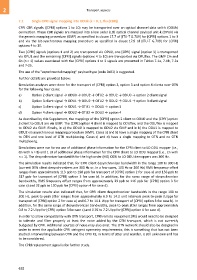Page 638 - 5G Basics - Core Network Aspects
P. 638
2 Transport aspects
7.1 Single CPRI signal mapping into ODUk (k = 0, 1, flex(CBR))
CPRI CBR signals ([CPRI] options 1 to 10) may be transported over an optical channel data unit-k (ODUk)
connection. These CBR signals are mapped into a low order (LO) optical channel payload unit-k (OPUk) via
the generic mapping procedure (GMP) as specified in clause 17.7 of [ITU-T G.709] for [CPRI] options 1 to 3
and via the bit-synchronous mapping procedure as specified in clause 17.9 of [ITU-T G.709] for [CPRI]
options 4 to 10.
Two [CPRI] signals (options 1 and 2) are transported via OPU0, one [CPRI] signal (option 3) is transported
via OPU1 and the remaining [CPRI] signals (options 4 to 10) are transported via OPUflex. The GMP Cm and
Cn (n = 1) values associated with the [CPRI] options 1 to 3 signals are presented in Tables 7-1a, 7-1b, 7-2a
and 7-2b.
The use of the "experimental mapping" payload type (code 0x01) is suggested.
Further details are provided below:
Simulation analyses were done for the transport of [CPRI] option 2, option 3 and option 4 clients over OTN
for the following four cases:
a) Option 2 client signal → ODU0 → ODU2 → OTU2 → ODU2 → ODU0 → option 2 client signal
b) Option 3 client signal → ODU1 → ODU2 → OTU2 → ODU2 → ODU1 → option 3 client signal
c) Option 3 client signal → ODU1 → OTU1 → ODU1 → option 3
d) Option 4 client signal → ODU2 → OTU2 → ODU2 → option 4
As described by this Supplement, the mappings of the [CPRI] option 2 client to ODU0 and the [CPRI] option
3 client to ODU1 are via GMP. The [CPRI] option 4 client is mapped to ODUflex, and the ODUflex is mapped
to ODU2 via GMP. Finally, in a) the ODU0 is mapped to ODU2 via GMP and in b) the ODU1 is mapped to
ODU2 via asynchronous mapping procedure (AMP). Cases a) and b) have a single mapping of the CPRI client
to OTN and one level of OTN multiplexing. Cases c) and d) have a single mapping to OTN and no OTN
multiplexing.
Simulations were run for no use of additional phase information for the CPRI client to LO ODU mapper (i.e.,
Cn with n = 8) and 1 UI of additional phase information for the CPRI client to LO ODU mapper (i.e., Cn with
n = 1). The desynchronizer bandwidth for the high order (HO) ODU to LO ODU demappers was 300 Hz.
The simulation results indicated that, for CPRI client desynchronizer bandwidth in the range 100 to 300 Hz
(current OTN client desynchronizers are 300 Hz or, in a few cases, 100 Hz or 200 Hz) RMS frequency offset
ranges from approximately 113 ppb to 190 ppb for transport of [CPRI] option 2 for case a) and 156 ppb to
317 ppb for transport of [CPRI] option 3 for case b). In addition, for the same range of desynchronizer
bandwidths, RMS frequency offset ranges from approximately 29 ppb to 116 ppb for [CPRI] option 3 for
case c) and 32 ppb to 130 ppb for [CPRI] option 4 for case d).
The simulation results also indicated that, for CPRI client desynchronizer bandwidth in the range 100 to
300 Hz, peak-to-peak jitter ranges from approximately 6.9 to 14.2 unit intervals peak-to-peak (UIpp) for
transport of [CPRI] option 2 for case a) and 6.7 to 14.1 UIpp for transport of [CPRI] option 3 for case b). In
addition, for the same range of desynchronizer bandwidths, peak-to-peak jitter ranges from approximately
0.8 to 7.2 UIpp for [CPRI] option 3 for case c) and 0.76 to 7.2 UIpp for [CPRI] option 4 for case d).
In order to allow compatibility with OTN transport, CPRI remote equipment (RE) would need to be designed
to tolerate and filter properly at least the noise added by the OTN transport, which is not currently
budgeted by CPRI. Additional sources of noise may also exist. The OTN network should also be designed in
order to meet the applicable CPRI stringent symmetry requirements; this is something that has not been
studied. Interworking between OTN and the CPRI RE, in terms of jitter and wander, is still unknown and has
to be considered.
The CPRI replacement signal is for further study.
628

